Abstract
Livestock depredation is a major conservation challenge globally, causing significant economic losses to pastoralists and threatening large carnivore species outside protected areas. Our study investigated the temporal and spatial distribution of livestock depredation incidences, carnivore species associated with livestock depredation, and assessed mitigation measures in Maasai Mara Conservancies in Southern Kenya. Using daily monitoring of livestock depredation cases, we made comparisons between livestock attacks occurring in predator-proof bomas and those with traditional kraals. A total of 305 livestock depredation incidents were recorded between January and December 2021, translating to a total tally of 1411 livestock maimed or killed. Most livestock depredation incidents occurred during the day (59%) as opposed to night (41%), but this difference was not significant. Livestock depredation incidents in the nighttime occurred mostly inside traditional kraals (34%) and occurred the least in predator-proof kraals (2%). Lions were responsible for more livestock attacks in the grazing fields compared with leopards, hyenas, and wild dogs. Hyenas were more daring and attacked livestock inside traditional bomas relative to lions and leopards. Our study concludes that predator-proof bomas are more effective in minimizing livestock depredation and can be embraced as a sound intervention for human–carnivore co-existence in communities’ wildlife conservation areas.
1. Introduction
Livestock depredation by mammalian carnivores is a form of human–wildlife conflict and a widespread phenomenon globally. It poses a major conservation challenge to large and threatened carnivore species, particularly those residing outside protected areas, and causes significant economic losses to farmers. The expanding human population and subsequent requirement for more space for settlement and agricultural production have led to the loss, degradation, and fragmentation of habitats, bringing livestock and carnivores into close proximity. This results in intense human–wildlife conflicts [1,2]. Further, ecological conditions relating to climate change continue to intensify livestock depredation by exacerbating wild prey scarcity and forcing people and predators to share increasingly crowded spaces [3,4]. Poor guarding practices such as leaving the livestock under the care of children, larger herds versus one herder, location of grazing pastures close to protected reserves, and a lack of animal shelters also impact the extent of predation on livestock [5]. Certainly, livestock depredation incidences are on the increase in Kenya [6,7,8].
Sub-Saharan Africa, particularly in the terrestrial savanna settings, is dominated by pastoralist communities who largely share grazing grounds with wild animals. In Botswana, pastoralists lose significantly high numbers of cows to lions and hyenas [9]. However, livestock predation offset schemes initiated to mitigate communities’ retaliation against predators were biased despite the high attack incidences because the consolation payments cover specific kills from particular predators of interest to the stakeholder supporting wildlife offsets from predation, leaving out other carnivore species. In the northern parts of Tanzania, not only are large carnivores including lions, leopards, spotted hyenas, and wild dogs reportedly associated with livestock depredation in the communal lands but also smaller carnivores such as striped hyenas and caracal [10]. This scenario is quite similar in Kenya, where predation of livestock is rampant in communal lands harboring about 70% of Kenya’s wildlife. In the Amboseli ecosystem in Southern Kenya, an annual loss amounting to USD 4820 per household due to livestock depredation mainly by lions and hyenas was reported by Muriuki [11]. Similarly, ranchers and pastoralists in rangelands within the Northern parts of Kenya suffered annual losses amounting to USD 40 per household [12], resulting from large carnivore attacks. These scenarios present challenges encountered by communities sharing space with wildlife in terms of economic losses that affect their livelihoods and species conservation initiatives, particularly those involved with the conservation of threatened carnivores found outside protected areas [13].
An understanding of patterns and prevalence of livestock depredation incidences is critical in designing effective mitigation measures and enhancing carnivore species conservation in human–wildlife interface areas. We investigated livestock depredation in selected community conservancies in the Maasai Mara ecosystem, Kenya. Past studies in the Mara ecosystem centered on livestock depredation in areas with close proximity to the protected area [14] or in the expansive regions outside protected areas in Narok County [6]. “Bomas” or “Kraals” are traditional, low-tech practices where livestock are enclosed by night to keep predators at bay (Figure A1 and Figure A2). The bomas have been fairly effective in a few areas in Kenya in minimizing livestock depredation rates and conversely help in conserving large predators which are killed via retaliatory attacks [15]. Our study concentrated on livestock depredation within conservancies characterized by the close interface between wildlife and human beings, thus refining investigations by Kolowski [14] and Mukeka [6]. We assessed (1) the temporal and spatial distribution of livestock depredation incidences in selected conservancies in the Mara ecosystem; (2) carnivore species associated with livestock depredation; and (3) mitigation measures, especially bomas, employed by local people and their respective successes in countering livestock depredation attacks.
2. Materials and Methods
2.1. Study Area
The study was conducted in four conservancies in the Southern part of the Mara ecosystem, namely, Mara Siana (10,000 acres), Ol Kinyei (18,641 acres), Naboisho (53,446 acres), and Olare Motorogi (33,386 acres). The studied conservancies’ boundaries are contiguous to Maasai Mara National Reserve and are therefore key wildlife dispersal areas (Figure 1). The study area is located in Narok County, which lies in Southwest Kenya. Narok County borders the Republic of Tanzania to the South, Migori County to the West, Kisii, Nyamira, Bomet, and Nakuru County to the North, and Kajiado County to the East.
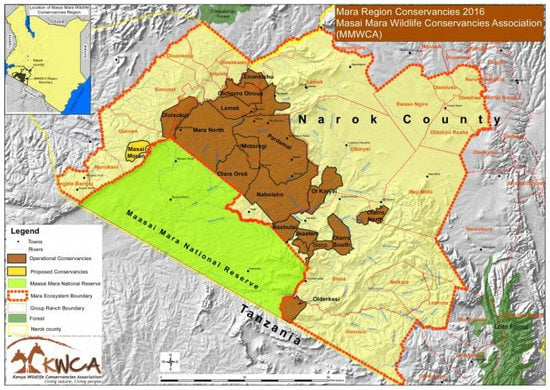
Figure 1.
Study Area.
The Mara ecosystem is dominated by four vegetation types: bushed and wooded grassland, semi-evergreen thickets, and grassland on clay plains [16]. This vegetation supports large populations of both grazers and browsers while providing ambient cover for predators.
The Mara ecosystem is rich and diverse in wildlife species. However, increasing pressures from livestock, agriculture, and poaching activities are negatively impacting wildlife species, leading to rapid population declines. The reduction of rangelands’ space and the scarcity of the available natural resources (water, grass, and mineral salts) have amplified competition between livestock, wildlife, and humans. Further, little or no wildlife is found in the north or northeast of the Mara ecosystem due to expanding agriculture, human settlements, and fencing.
The main land uses in the Mara ecosystem include semi-nomadic pastoralism, arable farming, tourism-based wildlife conservation, and forestry. Pastoralism is the main source of livelihood for the local Maasai community, although migrant ethnic communities and foreign firms carry out large-scale crop production of wheat, barley, maize, and beans.
Thus, livestock keeping is the prevalent socio-economic activity for the local Maasai communities who attach a high value to livestock keeping. They keep large herds of livestock, with approximate herds of 1.4 million cattle, 1.2 million sheep, and 0.8 million goats [17]. The migrant ethnic communities, such as the Kipsigis and Kisii, and foreign firms carry out large-scale crop production of wheat, barley, maize, and beans. The non-native Kipsigis and Kisii communities are migrants from neighboring Bomet and Kisii counties and are settled in Narok County by either purchasing or leasing land from the local Maasai community. The migrant community are introducing crop farming on acquired pieces of land, traditionally not practiced by the Maasai.
2.2. Data Collection
We carried out day-to-day records of livestock depredation cases for 12 months continuously between January and December 2021. We collected data using standard monitoring sheets that entailed the name of the conservancy, date, time of the attack (nighttime or daytime), location of attack (inside the traditional boma (kraal), outside boma, grazing field, inside predator-proof boma), carnivore involved (lion, leopard, spotted hyena, unknown, or others), livestock attacked (cattle, sheep, goat, others). The number of livestock present at the time of the attack was not recorded as a typical Maasai pastoralist is usually unwilling and uncomfortable to divulge details of livestock herd, especially in terms of exact number of livestock owned; this is a cultural aspect within the Maasai community which the researchers did not want to go against.
The traditional kraal (boma) is a structure within a homestead constructed by piling up twigs, thorny branches/bushes, wood posts, chain links, and/or live vegetation to herd livestock at night for security purposes [18] (Figure A1 and Figure A2). The predator-proof bomas (PPB) are constructed by upgrading the traditional kraal (bomas) by reinforcing the structure with posts, rolls of chain links, and iron sheet or flattened oil drum doors as a gate (Figure A3). Outside boma locations are cases where livestock are not herded within any security structure but found in the open. In contrast, the grazing fields are located within the expansive conservancies where livestock have access to pasture and water during the day. During this period, the herds of livestock are tended to by headers. The herders can either be employed personnel or alternatively children within the family.
We obtained maps of existing predator-proof bomas (PPB) from conservancies for monitoring purposes (Figure 2). One model PPB was constructed in each conservancy that did not have any PPBs for data collection. The PPB in the study area entailed upgrading or fortifying traditional Maasai livestock bomas by adding posts, rolls of chain links, and flattened oil drum doors. To monitor the effectiveness of PPB in preventing livestock attacks, observations and examinations of the performance of the established PPBs were carried out to establish their effectiveness in controlling livestock depredation. Comparisons were conducted between livestock attacks in manyattas/villages with predator-proof bomas and those without PPBs or with traditional kraals to establish their effectiveness as conflict mitigation measures.
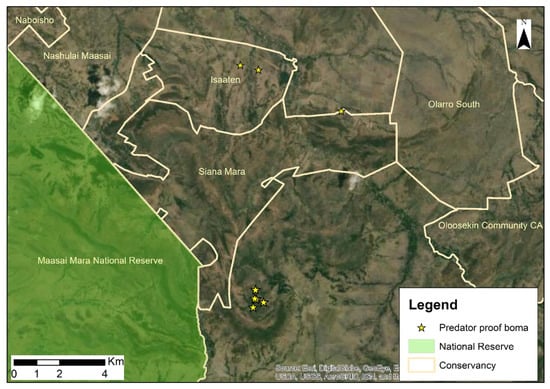
Figure 2.
Existing Predator-Proof Bomas.
2.3. Data Analysis
Data analysis was based on general time (day and night) and seasons (dry/wet season). Livestock attack cases were investigated in relation to the conservancy, location of predation, carnivore species involved, and livestock attacked. The location of predation was indicated as either inside traditional boma (kraal), outside boma, in the grazing field, or inside a PPB. The collated information was analyzed in relation to the conservancy, carnivore species involved, and livestock species attacked. Data were subjected to a chi-square test, where a larger disagreement between observed and expected frequencies results in a larger χ2 value. The fit of a larger χ2 value was obtained in the worst-case scenario [19]. In this study, a 0.05 level of significance was used to determine the relationship existing between data categories and concluding the study.
3. Results
3.1. Livestock Depredation Incidences and Livestock Predated on
A total of three hundred and five (305) livestock depredation incidents were recorded between January and December 2021 in the four conservancies under investigation. These involved mostly sheep (44%) and goats (29%) compared to cows (27%) (Plate A3). The attack incidents translated to a total tally of one thousand four hundred and eleven (1411) livestock maimed or killed. Most livestock attacked were killed (844) compared to those maimed in the course of attack (567) (Figure 3).
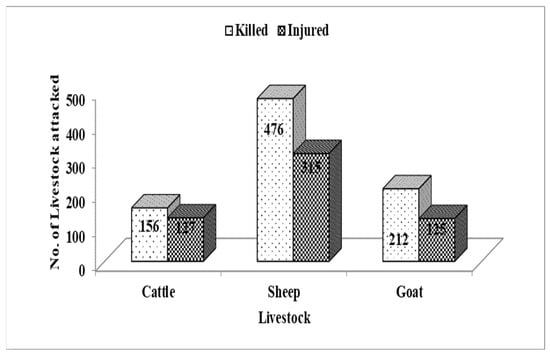
Figure 3.
Number of livestock killed or injured in livestock depredation incidences.
3.2. Distribution of Livestock Depredation in Time and Space
3.2.1. Seasonal Prevalence of Livestock Depredation Incidences
Most depredation cases were recorded in May (18%) and June (24%) and the least in September (2%) and December (0.7%), with a range of 70. In terms of quarterly distribution of attack incidences, over half (57%) of these incidences were recorded between April and June, a period coinciding with the wet season in the ecosystem, while October–December recorded the least (5.5%).
3.2.2. Temporal Patterns of Livestock Depredation
Most livestock depredation incidents occurred during the day (59%) compared with at night (41%). The number of attacks, however, did not differ significantly (χ2 = 9.36, df = 11, p > 0.005).
A close association between time and location of livestock depredation incidences was recorded (χ2 = 213.92, df = 3, p < 0.001). Most attacks occurred in grazing fields (44%) during the day, while livestock depredation incidents in the nighttime occurred predominantly inside traditional kraals (34%) or outside kraals (20%), and the least occurred in predator-proof or enhanced livestock kraals (2%).
Further, time influenced the predator attacking livestock (χ2 = 50.095, df = 3, p < 0.000). Most livestock attacks during the day were caused by lions (75%) and leopards (73%), whereas nighttime incidents were associated with hyenas (68%). Similarly, time was a factor in livestock species attacked (χ2 = 7.143, df = 2, p < 0.028), in that cattle (63%) and goats (67%) were more predisposed to attacks during the day than the night. However, incidences of depredation on sheep were the same during the day and night (50%). Further, livestock species attacked in relation to the time of attack showed slight variation at a 10% precision error (χ2 = 7.143, df = 2, p < 0.028).
Similarly, findings revealed a significant association (χ2 = 1.991, df = 3, p < 0.574) between time of livestock depredation and the conservancy. Cases of depredation were high during the daytime in all conservancies, with Naboisho conservancy recording the highest number of livestock depredation incidents (Table 1).

Table 1.
Time of livestock depredation in relation to conservancies.
3.2.3. Spatial Patterns of Livestock Depredation
Location of Livestock Depredation Occurrence in the Conservancies
In terms of location in relation to the conservancies examined, Naboisho conservancy recorded the highest number of livestock depredation incidences (30%), followed by Olkinyei conservancy (27%), while Olare Orok (24%) and Siana (19%) conservancies experienced the least cases of livestock depredation incidences. However, there were no significant differences in the number of incidences recorded (χ2 = 20.13, df = 33, p > 0.005) in respective conservancies during the reporting period.
In terms of site of attack within the conservancies, results demonstrated a slight variation at a 10% precision error (χ2 = 16.226, df = 9, p < 0.0621). Most attacks occurred in grazing fields particularly in Ol Kinyei and Naboisho conservancies, whereas incidents inside traditional bomas (kraals) were recorded in Olare Orok and Naboisho conservancies. The least cases occurred inside enhanced or predator-proof bomas, mostly found in Olkinyei and Siana conservancies (Figure 4).
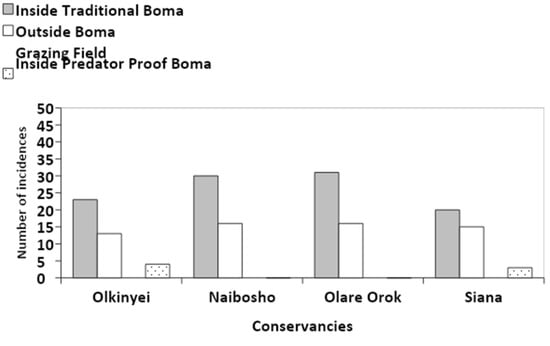
Figure 4.
Distribution of livestock depredation in conservancies.
Sites of Livestock Depredation and Livestock Species Predated on
We examined livestock depredation incidences in terms of attack sites in relation to the livestock species predated on. There was no association (χ2 = 10.525, df = 6, p< 0.104), implying that all livestock species, that is, cattle and shoats (sheep and goats), were vulnerable to attack irrespective of location, whether in grazing fields or herded in pens (Table 2).

Table 2.
Distribution of livestock depredation incidences in relation to the location of attack and livestock species predated on.
3.3. Carnivore Species Involved in Depredation and Livestock Attack Site
The study examined carnivore species involved in attacks to ascertain the level of association between carnivores involved, livestock predated on, and the attack site. Findings revealed a significant association (χ2 = 77.121, df = 9, p < 0.000) between the attack site and carnivore species involved. Lions were responsible for more livestock attacks in the grazing fields as compared to leopards, hyenas, and other carnivore species such as wild dogs and serval cats. Hyenas were more daring and attacked livestock inside traditional bomas relative to lions and leopards. Lions and leopards also attacked unprotected livestock found outside kraals, whereas both lions and hyenas breached protected bomas to attack livestock inside predator-proof bomas, but only in rare cases (Figure 5).
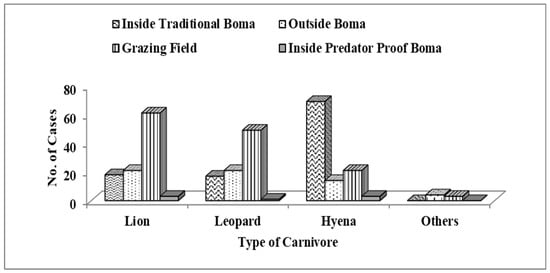
Figure 5.
Distribution of livestock depredation incidences in relation to the location of attack and carnivore species involved.
4. Discussion
Livestock depredation presents one of the greatest wildlife conservation challenges evident in the human–wildlife interface around the world [20,21]. Thus, understanding their patterns and prevalence is critical to designing effective interventions to promote coexistence in landscapes with close human–wildlife interactions.
4.1. General State of Livestock Depredation in Community Conservancies
From the results, the yearly statistics of livestock predated on and the economic losses incurred by communities have been revealed, and more so for the Maasai pastoralists whose main source of livelihood and life savings are held in livestock herds. Such losses breed a negative outlook, particularly if consolation or compensation measures do not exist.
The study investigations did not focus on the ratio of livestock attacked to the entire flock or herd. The average optimal livestock market price and the value pastoralists attach to livestock, recorded incidents, and the resulting livestock attacks show the immensity of the problem encountered by communities in conservancies. These wilderness areas are the few remaining zones acting as wildlife refuge areas, whose existence offers promise to wildlife survival. Devising measures to promote co-existence and to minimize such attacks would guarantee a future for these predators. Compared to findings by [6], there is a general notion of under-reporting livestock depredation incidences. Not all attacks are reported to the Kenya Wildlife Service, the country’s national agency in charge of wildlife management. This could be attributed to a lack of compensation or a slack response in the case of reporting, thereby discouraging community members. The continued occurrence of livestock depredation incidents often led to communities resorting to retaliatory killings of the carnivores involved, thus affecting the survival of these species, particularly endangered ones.
4.2. Temporal and Spatial Distribution of Livestock Depredation Incidents. Seasonal Prevalence of Livestock Depredation Incidences
Livestock depredation was prevalent in the wet season, coinciding with a period when most wildlife ventured out of the protected area. During the wet season grass in MMNR is tall, the grass biomass, pushes away majority of the wild grazers to conservancies, a situation that compels predators’ to follow. These findings corroborated with Mukeka [5] and Manoa [18], who noted that most human–wildlife conflicts occurred during the wet season when the migrant wildlife species had moved from the Serengeti to the Mara side and resident herbivores ventured out into adjacent conservancies harboring the most livestock. This could therefore be linked to predator–prey relations, where certain carnivore species followed the movement of some of their main prey species during the wet season and thus come in frequent contact with livestock and people in areas adjacent to protected areas [22]; this movement consequently contributes to high cases of human–carnivore conflict and retaliatory killing of problematic carnivores [22]. Communities could zone conservancies to create dry, wet, and seasonal grazing grounds to mitigate the conflicts. This mechanism could particularly target areas devoid of predators, especially when most have ventured out of the protected area. Further, simple and cost-effective measures, such as false “eye” painting on livestock, are currently being piloted in Mara Siana and Olare Motorogi conservancies to help guard livestock against attacks while in grazing fields.
4.3. Spatial Distribution of Livestock Distribution
Livestock depredation incidents were prevalent in all the conservancies. This could be attributed to multiple biological and environmental factors such as livestock herd size, livestock–herder ratio, age of the herder (children or adults), herding patterns, guarding skills, predator species involved, and the proximity of human settlements [23,24] that are often overlooked by the community and wildlife authorities during the planning phase. The larger the herd, the higher the likelihood of losing livestock to predation. The scenario is amplified when one or few herders guard or herd large livestock numbers with the prevalent occurrences augmented when children are herding during school holidays.
Although most predation occurred inside homesteads, colossal livestock kills were observed when grazing (cattle 42%, sheep 49%, and goats 43%) as elucidated in this study. This suggests the vulnerability of livestock, particularly with weak interventions to keep predators at bay. As such, cost-effective measures such as predator-proof bomas (PPB) or enhanced traditional bomas improved livestock security particularly at night, as proved by a few cases recorded. However, such simple and cost-effective measures have not yet been widely embraced by communities in the community conservation areas of Mara.
4.4. Carnivore Species Involved in Livestock Depredation
Hyenas and lions are the most problematic wild animal species in livestock depredation. Hyenas attacked livestock mostly at night inside traditional kraals/bomas. This can be attributedto their scavenging habits, because they are attracted to the human settlements by decomposing litter in the area [6], ideally providing an opportunistic avenue to break into kraals. Lions, on the other hand, were more daring during the day, attacking livestock in grazing fields with few cases reported inside traditional bomas at night. Lions would mostly attack cows rather than shoats to obtain maximum energy equivalent to their wild prey such as buffaloes, zebras, and wildebeests. As such, cows were easy prey for lions especially while on a grazing field. Conversely, old lionesses occasionally attacked shoats such as in Siana. The interaction between wild dogs and other carnivores can trigger HCC. In cases where hyena and wild dog densities are high, competition between these species over prey amplifies, thus compelling wild dogs to relocate to new habitats [25]. The behavioral responses of the wild dog in the context of interference competition and predation triggers them to respond by attempting to reduce their predation risk via changes in their spatial or temporal utilization patterns [26]. Wild dogs have been recorded traversing land with high human density as they travel hundreds of kilometers, and HCC may be high during this period [27].
Further, predators such as leopards, hyenas, and wildcats would cause multiple attacks on livestock mostly herded in traditional kraals. The traditional kraals predispose livestock to attacks as they are easily accessible and more vulnerable due to a lack of escape routes. As such, use of fortified kraals could be an intervention to address depredation.
Additionally, heightened depredation cases in specific conservancies, particularly Naboisho and Olkinyei, could be a factor of livestock and predator population rather than conservancy size.
4.5. Livestock Keeping Is a Major Wildlife-Conservation-Compatible Land Use Practice
Pastoralism and livestock keeping are considered as wildlife-conservation-compatible land use practices as compared to crop production that alters and encroaches into wildlife space. This is evidenced by the existence of livestock and wildlife side-by-side in rangelands. In this case, livestock–wildlife interactions have pros and cons. Although livestock and wildlife can mutually facilitate diseases, they enable reciprocal benefits, making their interaction compatible [28]. Livestock have supported wildlife abundance in rangelands that have been mowed by livestock [29]. Predators thrive in areas with short grass to hunt. Lions do not like wet surfaces with long grass, and that is why this study indicated incremental predation during the wet season when the grass in the Maasai Mara National Reserve (MMNR) is excessively tall, necessitating lions to move to communal areas where there is a constant livestock presence. Short grass can be activated biologically when it is grazed either by wild or domestic species [30].
In human settlements, leopards are active late in the evening and cover a large range, thus attacking livestock at night [31]. The body size, greater resilience, and adaptability to successfully live in the proximity of humans are some of the reasons why leopards are involved in HCC [32]. In Kenya, much of wild dogs’ current geographical range falls outside PAs [33]. They have been recorded traversing land with a high human density as they travel hundreds of kilometers, and HCC may be high during this period [27]. As such, measures promoting coexistence need to be adopted by pastoral communities to maintain this state.
4.6. Possible Mitigative Measures to Promote Co-Existence
Livestock depredation inflicts huge losses to communities. With the lack of wildlife offsets/consolation fees, most community members resort to revenge when wildlife destroys property (crops and livestock) [34] or when wildlife injures or kills their people. In the Mara, the conservancies are struggling to mitigate heinous livestock carcass poisoning as a retaliatory mechanism to express their anger in scenarios where their livestock are killed, whose impact cascades across multiple predator species (lions, hyenas, jackals, and vultures, among others).
For the community to appreciate wildlife conservation, it must encourage coexistence with minimal HWC incidences. Peaceful human–wildlife interaction is attained when the affected communities do not act to endanger the species but to devise long-term desirable solutions. People threaten wildlife when their livelihoods are endangered [35,36] because of negative attitudes that often promote and amplify retaliatory killings, thus undermining wildlife dignity [36]. Communities exact revenge when wildlife destroys property (crops and livestock) [34] or when wildlife injures or kills their people. Incentivizing communities with wildlife benefits can adjust their attitudes, perceptions, and actions toward wildlife. Imparting the community with the capacity to own and sustainably enjoy wildlife resources can ultimately communicate a positive message, thus minimizing human wildlife–related atrocities. Integrating community development programs can embolden tranquil and simultaneous living between humans and wildlife [12]. Local communities neighboring wildlife ecosystems can buy into the idea of wildlife conservation when substantial revenues are generated from this very resource through tourism [37].
Livestock consolation or offsets might be a short-term remedy to address Human–Carnivore Conflicts (HCC), especially in deterring people from retaliating. However, this action is short-term because it is expensive [38,39], and difficulties in confirming predation incidences are not transparent and are therefore unsustainable. Zoning conservancies to create livestock–wildlife interfaces is fundamental in mitigating routine HWCs. Reinforcing and upgrading the traditional kraals to predator-proof bomas (PPB) would deter night attacks, intensive awareness programs would encourage uptake of contemporary livestock rearing pattern concepts, and folding and jettisoning the usual traditional pastoralism lifestyle is fundamental in reducing predation. Communities fencing homesteads can provide the first buffer to cushion and deter prey from easily accessing livestock kraals that are currently in the open, especially at night. Conveying wildlife information regularly by conservancy authorities to herders on wildlife presence can significantly assist in averting livestock depredation.
Part of the reason why wildlife are translocated is to evade human–wildlife-related conflicts because of conflicting interests as part of meeting the conservation objective [40] in the interest of species, people, and wildlife authorities. Translocations also stimulate public attention in scenarios where popular flagship species are involved, thus encouraging greater public interest in conservation work [40]. These animal movements sometimes necessitate the community to generate the desired and innovative ideas by propagating a conservation ethos that might generate sustainable solutions to the contemporary conservation quagmire between people and wildlife as land continually becomes squeezed.
5. Conclusions
Community wildlife conservancies are important refuges for large wildlife species, particularly large carnivores that cannot be confined in protected areas. Hence, successful conservation of these species will largely be anchored on livestock depredation mitigation in these human–wildlife interface landscapes to promote coexistence.
Evidently, livestock were vulnerable to attack in grazing fields and inside traditional bomas, which occurred during the day and night, respectively. This promoted the need to devise innovative mitigation measures for livestock while grazing, and intensifying sensitization and awareness creation about predator-proof bomas to reduce attacks at night. The measures particularly target community members who still herd livestock in traditional bomas that are easily accessible. Although few community members have adopted innovative mitigation measures such as predator-proof bomas (PPB), there is a need to upscale them. Currently, the government compensation scheme towards property loss due to wildlife is strictly applicable only to those with reasonable protective measures in place, thus underscoring the necessity for additional measures to secure livestock. Low cases of attacks in predator-proof bomas (kraals) points to their effectiveness in restraining carnivores from attacking livestock. Therefore, enhancing livestock security at night by the adoption of predator-proof bomas (kraals) would promote coexistence by substantially minimizing livestock depredation and subsequently retaliatory killings arising from such incidences. Further, monitoring should be conducted to establish the efficiency rate of PPBs in controlling livestock depredation.
Author Contributions
All authors contributed to the research and development of this article; E.W., D.M.S. and E.S. worked on conceptualization; methodology; formal analysis; original report and draft preparation; and writing the review. H.I., P.W.W. and T.F. helped in funding acquisition to ensure objectives were achieved. H.I. and P.W.W. supervised the project and helped with the reviews. All authors have read and agreed to the published version of the manuscript.
Funding
This research was funded by the Rufford Foundation, grant number 30057-2.
Data Availability Statement
All the data we had have been used in this article, the other information/report can be found on the Rufford Foundation website https://www.rufford.org/projects/elizabeth-wakoli/human-wildlife-conflict-in-conservancies-within-the-mara-ecosystem/ (accessed on 1 March 2023).
Acknowledgments
The authors are indebted to the Rufford Small Grant Foundation (Grant No. ID 30057-2; Elizabeth Wakoli—Human Wildlife Conflict in Conservancies within the Mara Ecosystem—The Rufford Foundation) for funding this research. We also acknowledge the management of Mara Siana, Olkinyei, Naibosho, and Olare Orok conservancies and Enkaretoni Community Based Organization for their support during data collection. We would also like to thank the local community members in the study conservancies for their assistance during data collection.
Conflicts of Interest
The authors declare no conflict of interest. The funders had no role in the design of the study; in the collection, analyses, or interpretation of data; in the writing of the manuscript; or in the decision to publish the results.
Appendix A
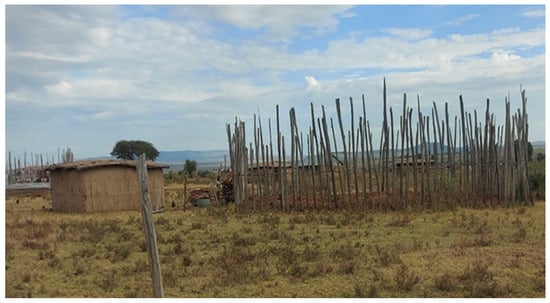
Figure A1.
Traditional Kraal build using posts.
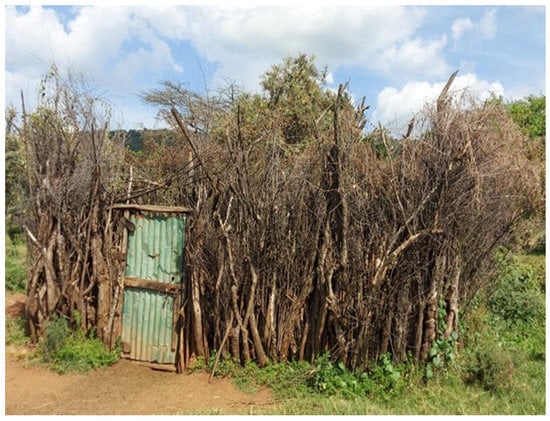
Figure A2.
Traditional Kraal build using twigs and tree branches.
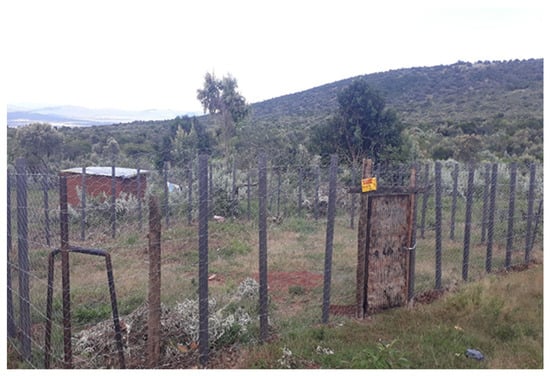
Figure A3.
Predator-Proof Boma/Kraal.
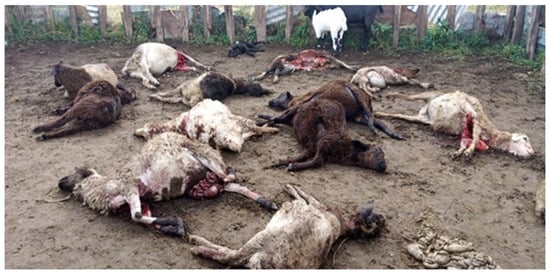
Figure A4.
Sheep Killed by Hyena in Mara Siana.
References
- Acha, A.; Temesgen, M. Approaches to Human-Wildlife Conflict Management in and around Chebera-Churchura National Park, Southern Ethiopia. Asian J. Conserv. Biol. 2015, 4, 136–142. [Google Scholar]
- Berihun, A.; Yirga, G.; Tesfay, G. Human-Wildlife Conflict in Kafta-Sheraro National Park, Northern Ethiopia. World J. Zool. 2016, 11, 154–159. [Google Scholar]
- Bastille-Rousseau, G.; Schaefer, J.A.; Lewis, K.P.; Mumma, M.A.; Ellington, E.H.; Rayl, N.D.; Mahoney, S.P.; Pouliot, D.; Murray, D.L. Phase-dependent climate–predator interactions explain three decades of variation in neonatal caribou survival. J. Anim. Ecol. 2016, 85, 445–456. [Google Scholar] [CrossRef]
- Abrahms, B. Human-wildlife conflict under climate change. Science 2021, 373, 484–485. [Google Scholar] [CrossRef]
- Naha, D.; Chaudhary, P.; Sonker, G.; Sathyakumar, S. Effectiveness of non-lethal predator deterrents to reduce livestock losses to leopard attacks within a multiple-use landscape of the Himalayan region. PeerJ 2020, 8, e9544. [Google Scholar] [CrossRef]
- Mukeka, J.M.; Ogutu, J.O.; Kanga, E.; Røskaft, E. Human-wildlife conflicts and their correlates in Narok County, Kenya. Glob. Ecol. Conserv. 2019, 18, e00620. [Google Scholar] [CrossRef]
- Li, X.; Buzzard, P.; Chen, Y.; Jiang, X. Patterns of Livestock Predation by Carnivores: Human–Wildlife Conflict in Northwest Yunnan, China. Environ. Manag. 2013, 52, 1334–1340. [Google Scholar] [CrossRef]
- Graham, K.; Beckerman, A.P.; Thirgood, S. Human–predator–prey conflicts: Ecological correlates, prey losses and patterns of management. Biol. Conserv. 2005, 122, 159–171. [Google Scholar] [CrossRef]
- LeFlore, E.G.; Fuller, T.K.; Tomeletso, M.; Stein, A.B. Livestock depredation by large carnivores in northern Botswana. Glob. Ecol. Conserv. 2019, 18, e00592. [Google Scholar] [CrossRef]
- Mkonyi, F. An integrated approach for the management of human-carnivore conflict: A review of conflict management interventions in Tanzania. Mamm. Biol. 2022, 2022, 1–21. [Google Scholar] [CrossRef]
- Muriuki, M.; Ipara, H.; Kiringe, J. The cost of livestock lost to lions and other wildlife species in the Amboseli ecosystem, Kenya. Eur. J. Wildl. Res. 2017, 63, 60. [Google Scholar] [CrossRef]
- Frank, L.G.; Woodroffe, R.; Ogada, M.O. People and predators in Laikipia District, Kenya. In People and Wildlife; Woodroffe, R., Thirgood, S., Rabinowitz, A., Eds.; Cambridge University Press: Cambridge, UK, 2005; pp. 286–304. [Google Scholar] [CrossRef]
- Treves, A.; Karanth, K.U. Human-Carnivore Conflict and Perspectives on Carnivore Management Worldwide. Conserv. Biol. 2003, 17, 1491–1499. [Google Scholar] [CrossRef]
- Kolowski, J.M.; Holekamp, K.E. Spatial, temporal, and physical characteristics of livestock depredations by large carnivores along a Kenyan reserve border. Biol. Conserv. 2006, 128, 529–541. [Google Scholar] [CrossRef]
- Ogada, M.O.; Woodroffe, R.; Oguge, N.O.; Frank, L.G. Limiting Depredation by African Carnivores: The Role of Livestock Husbandry. Conserv. Biol. 2003, 17, 1521–1530. [Google Scholar] [CrossRef]
- Dublin, H. Dynamics of the Serengeti-Mara Woodlands: An Historical Perspective. For. Conserv. Hist. 1991, 35, 169–178. [Google Scholar] [CrossRef]
- Psiwa, J.; Irungu, D.; Muriithi, S. Assessment of challenges facing the implementation of the county integrated development plan: A case study of narok county government. J. Strateg. Manag. 2017, 1, 1–23. [Google Scholar] [CrossRef]
- Manoa, D.O.; Mwaura, F. Predator-Proof Bomas as a Tool in Mitigating Human-Predator Conflict in Loitokitok Sub-County Amboseli Region of Kenya. Nat. Resour. 2016, 7, 28–39. [Google Scholar] [CrossRef]
- Heiberger, R.M.; Holland, B. Statistical Analysis and Data Display; Springer: New York, NY, USA, 2015. [Google Scholar] [CrossRef]
- Beattie, K.; Olson, E.R.; Kissui, B.; Kirschbaum, A.; Kiffner, C. Predicting livestock depredation risk by African lions (Panthera leo) in a multi-use area of northern Tanzania. Eur. J. Wildl. Res. 2020, 66, 11. [Google Scholar] [CrossRef]
- Broekhuis, F.; Cushman, S.A.; Elliot, N.B. Identification of human–carnivore conflict hotspots to prioritize mitigation efforts. Ecol. Evol. 2017, 7, 10630–10639. [Google Scholar] [CrossRef] [PubMed]
- Kissui, B.; Kiffner, C.; König, H.; Montgomery, R. Patterns of livestock depredation and cost-effectiveness of fortified livestock enclosures in northern Tanzania. Ecol. Evol. 2019, 9, 1–14. [Google Scholar] [CrossRef]
- Jackson, R.; Ahlborn, G.; Gurung, M.; Ale, S. Reducing Livestock Depredation Losses in the Nepalese Himalaya. In Proceedings of the Seventeenth Vertebrate Pest Conference 1996, Rohnert Park, CA, USA, 5–7 March 1996; Available online: https://digitalcommons.unl.edu/vpc17/30 (accessed on 12 June 2022).
- Dar, N.I.; Minhas, R.A.; Zaman, Q.; Linkie, M. Predicting the patterns, perceptions and causes of human–carnivore conflict in and around Machiara National Park, Pakistan. Biol. Conserv. 2009, 142, 2076–2082. [Google Scholar] [CrossRef]
- Creel, S.; Creel, N.M. The African Wild Dog: Behavior, Ecology, and Conservation; Princeton University Press: Princeton, NJ, USA, 2002; Volume 65. [Google Scholar] [CrossRef]
- Cozzi, G.; Behr, D.M.; Webster, H.S.; Claase, M.; Bryce, C.M.; Modise, B.; Mcnutt, J.W.; Ozgul, A. African Wild Dog Dispersal and Implications for Management. J. Wildl. Manag. 2020, 84, 614–621. [Google Scholar] [CrossRef]
- Woodroffe, R.; Rabaiotti, D.; Ngatia, D.K.; Smallwood, T.R.C.; Strebel, S.; O’Neill, H.M.K. Dispersal behaviour of African wild dogs in Kenya. Afr. J. Ecol. 2020, 58, 46–57. [Google Scholar] [CrossRef]
- Reid, R.S.; Thornton, P.K.; Kruska, R.L. Loss and fragmentation of habitat for pastoral people and wildlife in east Africa: Concepts and issues. Afr. J. Range Forage Sci. 2004, 21, 171–181. [Google Scholar] [CrossRef]
- Niamir-Fuller, M.; Kerven, C.; Reid, R.; Milner-Gulland, E. Co-existence of wildlife and pastoralism on extensive rangelands: Competition or compatibility? Pastor. Res. Policy Pract. 2012, 2, 8. [Google Scholar] [CrossRef]
- Odadi, W.O.; Karachi, M.K.; Abdulrazak, S.A.; Young, T.P. African wild ungulates compete with or facilitate cattle depending on season. Science 2011, 333, 1753–1755. [Google Scholar] [CrossRef]
- Kissui, B.M. Livestock predation by lions, leopards, spotted hyenas, and their vulnerability to retaliatory killing in the Maasai steppe, Tanzania. Anim. Conserv. 2008, 11, 422–432. [Google Scholar] [CrossRef]
- Kumbhojkar, S.; Yosef, R.; Benedetti, Y.; Morelli, F. Human-Leopard (Panthera pardus fusca) Co-Existence in Jhalana Forest Reserve, India. Sustainability 2019, 11, 3912. [Google Scholar] [CrossRef]
- KWS. Conservation and Management Strategy for Cheetah and Wild dog in Kenya. 2014. Available online: https://kws.go.ke/downloads (accessed on 14 February 2022).
- Bulte, E.H.; Rondeau, D. Why Compensating Wildlife Damages May Be Bad for Conservation. J. Wildl. Manag. 2005, 69, 14–19. [Google Scholar] [CrossRef]
- Mir, Z.R.; Noor, A.; Habib, B.; Veeraswami, G.G. Attitudes of Local People Toward Wildlife Conservation: A Case Study from the Kashmir Valley. Mt. Res. Dev. 2015, 35, 392–400. [Google Scholar] [CrossRef]
- Mogomotsi, P.K. An Institutional Framework for the Sustainable Co-Existence of Tourism and Agriculture in Botswana. 2019. Available online: https://repository.nwu.ac.za/handle/10394/33021 (accessed on 6 December 2022).
- Mariki, S.B. Conservation with a Human Face? Comparing Local Participation and Benefit Sharing from a National Park and a State Forest Plantation in Tanzania. SAGE Open 2013, 3, 2158244013512665. [Google Scholar] [CrossRef]
- Swenson, J.; Andrén, H. A tale of two countries: Large carnivore depredation and compensation schemes in Sweden and Norway. In People and Wildlife: Conflict or Coexistence? Woodroffe, R., Thirgood, S., Rabinowitz, A., Eds.; Cambridge University Press: Cambridge, UK, 2005; pp. 323–339. [Google Scholar]
- Zabel, A.; Holm-Müller, K. Conservation performance payments for carnivore conservation in Sweden. Conserv. Biol. 2008, 22, 247–251. [Google Scholar] [CrossRef] [PubMed]
- Carter, I.; Foster, J.; Lock, L. The Role of Animal Translocations in Conserving British Wildlife: An Overview of Recent Work and Prospects for the Future. Ecohealth 2017, 14 (Suppl. S1), 7–15. [Google Scholar] [CrossRef] [PubMed]
Disclaimer/Publisher’s Note: The statements, opinions and data contained in all publications are solely those of the individual author(s) and contributor(s) and not of MDPI and/or the editor(s). MDPI and/or the editor(s) disclaim responsibility for any injury to people or property resulting from any ideas, methods, instructions or products referred to in the content. |
© 2023 by the authors. Licensee MDPI, Basel, Switzerland. This article is an open access article distributed under the terms and conditions of the Creative Commons Attribution (CC BY) license (https://creativecommons.org/licenses/by/4.0/).